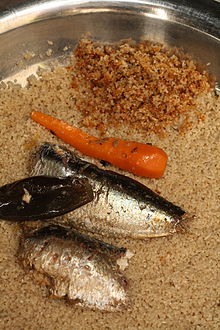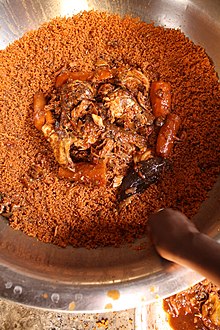food.wikisort.org - Dish
Tiep or thieb is a traditional dish from Senegal that is also consumed in Guinea-Bissau, Guinea, Mali, Mauritania, and The Gambia. It is the national dish in Senegal.[1] The version of tiep called thieboudienne or chebu jen (Wolof: ceebu jën; French: thiéboudiène) is prepared with fish, rice and tomato sauce cooked in one pot. There are also tiep yappa (with meat) and tiep ganaar (with chicken). Additional ingredients often include onions, carrots, cabbage, cassava, hot pepper, lime and peanut oil, and stock cubes.
This article has multiple issues. Please help improve it or discuss these issues on the talk page. (Learn how and when to remove these template messages)
|
 Tiep, made of rice, fish and vegetables | |
| Alternative names | Ceebu jën |
|---|---|
| Type | Main dish |
| Place of origin | Senegal |
| Cooking time | |
| Main ingredients | Fish and rice |
| Ingredients generally used | Vegetables |
| Variations | Meat |



Historically, tiep is commonly attributed to the city of Saint-Louis, in the nineteenth century. The name of the dish comes from Wolof words meaning 'rice' (ceeb) and 'fish' (jën).[2] In Pulaar it is known as maaro e liddi ('rice and fish'). It is served on large trays with the rice on the bottom and the fish, usually white grouper (Epinephelus aeneus), and the vegetables, many of them whole, placed in the center.
Traditionally it is eaten in a large communal dish with the hand. It is also the symbol of Senegalese terranga (hospitality): family, visiting friends and guests gather around a single dish (called a bolus) from which everyone eats using a spoon (couddou Pulaar) or a piece of bread.
The popular West African dish known as jollof is thought to have originated from the thieboudienne, but is usually made with meat rather than fish, and the rice is mixed into the other ingredients.[3]
The Gullah dish red rice resembles thieboudienne, suggesting a creolization of foodways from West Africa in the New World by enslaved Africans and their descendants. Like thieboudienne, there are regional variations of red rice throughout the Gullah/Geechee Cultural Heritage Corridor, including Savannah red rice and Charleston red rice.[4][5]
Recipe
It is a preparation of fresh or dried fish, and rice (rice Wolof), cooked with vegetables (such as cassava, pumpkin, cabbage, carrot, turnip, or eggplant), parsley, tomato paste, peppers, garlic and onions. Originally made with fish, it is nowadays frequent to see it served with beef or even chicken.
Variations
By country
Originally from Senegal, the traditional recipe includes fish, rice, tomato and onions. However, tiep is commonly consumed in several countries in West Africa. Depending on the country, the recipe and the ingredients change—even the method of cooking can differ. In Mali, tiep is known as tieb, a dish consisting of chicken, rice and vegetables such as a tomato and onion base. Another type of tiep is the jollof or djolof (in Wolof, the national language) rice also called benachin which means 'one pot' in Wolof. It is a popular dish especially in Nigeria and Ghana. In Cameroon and Ivory Coast the dish is called riz gras. The components are similar to the original recipe's ingredients with the inclusion of tomatoes, rice and onions.

By ethnicity
Senegal's distinctive ethnic groups have their own variations on cuisine and eating habits, influenced either by proximity to the ocean or the traditions of nomadism and cattle raising. For instance, people from southern Senegal usually also add some kouthia,[definition needed] while people from Dakar and Saint-Louis will use some soul (Wolof).

Other renderings
Other renderings of the name include: ceebu jen, cee bu jen, ceeb u jen, thebouidienne, theibou dienn, thiebou dienn, thiebou dinne, thiébou dieune, tíe biou dienne, thieb-ou-djien, thiebu djen or riz au poisson.[2]
See also
- Couscous
- Cuisine of Senegal
- Jollof rice
- Paprykarz szczeciński
- List of stews
- List of African dishes
References
- "Senegalese Fish and Rice (Thiéboudienne) Recipe". Saveur. Retrieved 2019-12-14.
- Troth Wells (15 March 2007). The World of Street Food: Easy Quick Meals to Cook at Home. New Internationalist. pp. 28–. ISBN 978-1-904456-50-6.
- Sloley, Patti (7 June 2021). "Jollof Wars: Who does West Africa's iconic rice dish best?". BBC Travel. Retrieved 16 July 2021.
- Harris, Jessica B. (2011). High on the Hog: A Culinary Journey from Africa to America. Bloomsbury USA. pp. 71–. ISBN 978-1-59691-395-0. - Registration required
- Dale Rosengarten; Theodore Rosengarten; Enid Schildkrout; Judith Ann Carney (30 September 2008). Grass roots: African origins of an American art. Museum for African Art. pp. 123, 125. ISBN 978-0-945802-50-1.
Further reading
- Senegal Travel Guide, World Travel Guide
- agricultural situation country report, USDA Foreign Agricultural Service,Mbalo Ndiaye,2007
- Food and daily life, Our Africa
- Duffy, Megan, "Ceeb ak Jën: Deconstructing Senegal’s National Plate in Search of Cultural Values" (2009). Independent Study Project (ISP) Collection. Paper 669.
На других языках
- [en] Thieboudienne
[es] Thieboudienne
Thieboudienne o ceebu jen es un plato tradicional de Senegal[1] considerado el plato nacional de este país.[2] Se compone principalmente de arroz (ceeb), pescado (jën) y salsa de tomate.[3]Другой контент может иметь иную лицензию. Перед использованием материалов сайта WikiSort.org внимательно изучите правила лицензирования конкретных элементов наполнения сайта.
WikiSort.org - проект по пересортировке и дополнению контента Википедии